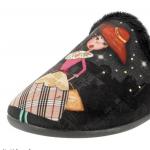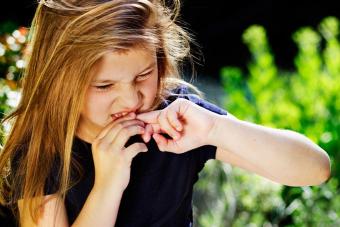Children will definitely like this paper parrot, as it is very easy and quick to make it. You can experiment with colors, combine a variety of bright shades. It is based on just a small piece of triangular paper and a few simple complementary details in the form of a beak, eyes, wings and paws.
Materials for work:
- Double-sided colored paper or cardboard of any shades;
- White paper for eyes or purchased moving eyes;
- A simple pencil, scissors, glue stick.
Do-it-yourself paper parrot: step-by-step instructions
We make a simple body
From cardboard or colored paper, cut out a triangle of any desired size. You can simply cut off a corner of the paper, taking into account that the two sides must be the same size.

Fold the triangle in half and crease in the middle.

Return to its original position, that is, open the folded triangle. Bend the right corner and point it down, aligning with the fold in the middle.

Then do the same with the left corner.

Apply glue to one of the sides (the place is marked with a cross), but do not use the area of \u200b\u200bhanging corners at the bottom.

Glue the other side to the adhesive area.

Bend the diverging corners below, this will be the tail of the parrot.

The body is a three-dimensional triangle.
Bend back the upper corner, and then make several cuts on it, you get a tuft.

It can be fluffed a little in different directions. The main part of the paper parrot is ready.

Final stage
Draw and cut out simple details for the parrot:
- Two wings made of colored paper or cardboard;
- two paws;
- Two parts of the beak;
- Two eyes.

Glue the beak on both sides of the fold on the front of the body so that it converges into a single whole. Slightly above the beak are the eyes, below are the wings, and at the very bottom are the paws.

If desired, feathers can be drawn on the wings or slightly smaller wings can be glued, repeating the shape of large ones, but of a different color.
The paper parrot is ready. Despite the long description, the whole process is very simple and fast. Successful creativity!

One of the ways to develop a child is to create paper crafts with your own hands. If you need to keep your child busy with a creative activity, then you can involve him in working together on an origami paper parrot. This will develop fine motor skills of hands, artistic taste, logic, as well as perseverance and imagination. This kind of activity will allow you to form the ability to concentrate on small details.
general information
There are several ways to create a colored parrot out of paper. The most popular of them are:
- classical;
- modular.
The first option is perfect for children who are just starting to master this skill. Creating a parrot from modules is a more difficult task that not everyone can handle.
 The art of creating a paper parrot with your own hands came to us from Japan. Even in ancient times, the art of origami was diligently developed in this country, after which it spread throughout the world. Using ordinary pieces of paper, you can easily create your own Kesha parrot or any other figurine. You can do it the classic way. in the form of processing plain paper. It is also possible to insert the tail and other modules into the paper structure separately.
The art of creating a paper parrot with your own hands came to us from Japan. Even in ancient times, the art of origami was diligently developed in this country, after which it spread throughout the world. Using ordinary pieces of paper, you can easily create your own Kesha parrot or any other figurine. You can do it the classic way. in the form of processing plain paper. It is also possible to insert the tail and other modules into the paper structure separately.
You need to stock up on a sufficient amount of patience and time, as well as plain paper. It is best to use not too thick paper designs. This will make it easier to perform the necessary actions on the figure.
First you need to prepare as much paper as possible. After that, you can figure out how to make a paper parrot. The schema looks like this:

To make a paper parrot using this method, it is recommended to follow a certain algorithm. It looks like this:

On this, the procedure for creating a parrot using the classical method can be considered completed. It remains only to draw eyes, feathers and color the whole craft.
Using modules
 In addition to the classic method, there is an opportunity to use the parrot's modular origami. The assembly scheme in this case implies creation of a complex structure in the form of a three-dimensional figure.
In addition to the classic method, there is an opportunity to use the parrot's modular origami. The assembly scheme in this case implies creation of a complex structure in the form of a three-dimensional figure.
To figure out how to make a parrot from the modules, special schemes will allow. It is best to start with simpler designs, since it is quite difficult to master such skill right away. You can use different colors for each module.
If such a craft turns out well enough, then it can be used as a decorative element of the interior in the house.
It's no secret that origami is a rather laborious art that requires perseverance, attention and free time. However, with the right approach to business, you can positively influence the development of the child, as well as have a great time in his campaign.















Making a parrot out of paper with your own hands is a rather difficult task and requires some skill and skill. There are various ways to make paper parrots using the origami technique. Some of them are laborious and painstaking, others are simpler. But, clearly, this is not a task for beginners. However, the effort is worth it. Beautiful paper parrots of different colors, executed with high quality and taste, made of good paper, look great as a decorative element. And just to please your child with an original craft is also an option. In our article, we will demonstrate to you the best manufacturing option, the simplest in terms of technology. Well, how to make more complex and voluminous options, you can see in the video additions to our article.
Making a paper parrot

To make an origami parrot, we need a square sheet of paper. You can use plain white A3 paper. But this is not at all necessary, any paper will do, it is only important to follow the form.

We fold the paper square diagonally, first in one direction, then, unfolding the folded sheet, in the other direction. Iron the fold lines with your fingers so that the fold is clearly visible. Visually, our square will be crossed by fold lines along two diagonals, with the intersection of these lines in the center.

The next step. Unfold the sheet and fold it in half. We iron the fold line. We straighten again, and fold in half, but in the other direction.

We get a paper square, divided by fold lines into four equal segments, with longitudinal diagonal folds.

...
We fold it in the way shown in the photo above, carefully ironing the fold lines and symmetrically combining the folded.

It turns out here is such a rhombus.

We wrap the outer corner of the rhombus with the open side inward, parallel to the fold line.

...
We do the same with all sides of our rhombus. We get a figure, as in the photo.

..
Carefully unfold one side of our figure and open it.

..
Carefully fold along the fold lines as in the photo above.

...
We do this on both sides. It turns out, as it were, an elongated rhombus with two free "legs" on one side.

...
We bend the top of the elongated rhombus to the so-called "legs"

...
After that, we turn the structure over to the other side, and proceed to the formation of the legs of the future parrot. To do this, bend the free sharp ends up, as shown in the photo above.

...
After that, we bend the sharp ends to the side.

..

..
We fold the workpiece with the legs inward. The contours of the future parrot are already beginning to be drawn - legs, body, wings.

..
Having straightened the edge of the upper part along the fold line, we press it with our finger inward and form a fold in the opposite direction. We iron the edges of the fold. We get an almost finished parrot head. It remains only to bend the beak and paws in the same way. Straightening the fold line and forming a fold in the opposite direction.

How to make a parrot out of paper / video /
paper parrot
beautiful paper parrot
origami parrot
Conclusion:
Video additions to our article will help you decide which parrot you want to make. And our explanations with photos will help you take the first steps in such an unusual but interesting direction as origami.
Parrots are perhaps one of the most intelligent birds, and therefore they constantly need some interesting and exciting activity. We can't spend all of our time with them, so toys serve the valuable function of keeping captive birds happy and less likely to develop unwanted behaviors such as pinching, screaming, or repetitive movements.
Unfortunately, for most parrots, the usual way to play is to chew on any favorite item, and if you buy the toys they need, the costs become global. With a little ingenuity and a lot of fun, you can create toys from household items, natural materials, and local materials without spending any money.
Interesting ideas for creating toys with your own hands
Wire hanger for climbing
Your pet will love this toy the most. Most of the cages are not large enough, and such a toy, without taking up much space, will allow the parrot to increase the territory for climbing.
- Hang a hook from the ceiling of the cage.
- Next, three loops are made that cling to each other.
- You can attach some treats for your pet along the entire length of such a creeper. And you can focus only on the bottom of such a hanger and tie a treat only at the bottom.
Ropes in the house, aviary and poultry house
In a room where birds can move outside the cage, handrails must be installed on hooks attached to the wall. Ropes are attached on both sides. Thus, the cable installed in a suspended state can be removed when your bird has played enough and is back in the cage.
Domestic budgerigars will be happy to play on the ropes for hours, swinging merrily. Once they stop climbing up and down the rope and swinging, it's time to let them rest. Parrots can be closed in a cage, and the ropes can be removed until the next bird walk. The same, but smaller, ropes can be hung in an aviary.
Before choosing some kind of swing rope for parrots, you should carefully inspect the rope for fraying, because the bird can catch on its leg and injure its neck.



Homemade toys for walking
Wrap a treat or toy in wicker and hang it in the cage. Instead of wicker material, you can use leaves of harmless plants or pine cones, small boxes that are used to store pills, and other similar household items.
Pet parrots will love to play with treats wrapped in a wicker rug and hung from the ceiling of the cage, like babies with Christmas presents.
Parrots often prefer the package to the toy or treat inside.
Balsam wood toys are sold and expensive, but parrots are very fond of walnut, they also like the soft type of wood very much. By the way, you can buy balsa wood in a store that sells materials for craftsmen.



willow wreath
- Make a circle of stiff wire and make sure the ends are securely tied. You can also use a hoop if there is enough space in the cage to hang it. You will need from 20 to 50 willow twigs to form a soft and beautiful wreath from 30 cm to 2 m.
- You can remove the willow leaves from the twigs, or you can leave them. Willow branches need to be wound on a wire circle or hoop. This is an easy activity that will take about 40 minutes of your time. The ends of the twigs can be tied with a thin wire. The next day, the wire attachments can be untwisted, the willow branches will retain their shape.
- You can hang treats, flowers or small toys on such a ready-made wreath made of natural materials. If you hang roses, your parrots will be happy to tear off and eat flower petals.
The willow wreath itself will last more than three months if a lot of threads are woven into it. Smaller wreaths can be made for cages.


home swing
Any tube with a hole through which you can thread a wire or rope is suitable for making a swing, where your parrots will happily swing or just sit. For hanging, you can use a rope, chain or plastic chain, which can always be purchased at a hardware store. Birds love to swing. Wild birds swing in trees, a behavior that is considered natural for pet parrots.



Flowers
Birds love to chew on flowers. In the diet of many wild birds are only flowers. If you are using purchased plants, not from your own garden, it is advisable to rinse them thoroughly to remove any existing preservative or insecticide.
Some flowers are poisonous, such as datura, laburnum, and foxglove.

Foliage
If your house is located outside the city and surrounded by its own garden, your parrot is very lucky, because it will not be difficult for you to collect dandelions, cut young willow branches, or collect fresh acorns for birds. Compared to urban greenery, the foliage outside the city does not contain dangerous insecticides and is not saturated with exhaust fumes.
In aviaries, shy birds are clearly happier when they have the opportunity to hide in the green foliage. For urban dwellers, there is such great advice as growing your parrot's favorite greens at home on the balcony, in clay pots. If it is not known where the foliage that you are going to add to the parrot's cage is from, then it is best to rinse it first.

Never use chemicals, household cleaners or bleach, for example, to disinfect bird toys.
Birds love branches. Disinfect twigs if they have any insects or herbicides on them. By the way, driftwood, once brought into the house from the beach, for example, will not only become an excellent decoration element for an aviary or a large cage - the birds will gladly climb on them.


Carton boxes
Small cardboard boxes will be a great toy for a parrot. Birds love to play with them. You can make a small birdhouse out of a cardboard box and you will see with what pleasure your parrot will climb on it and stay there during the day. Birds will not only hide in such a cardboard box, but will also chew and tear paper with pleasure.

Books
It doesn't say that you should let your favorite birds out in your home library. The best options are an old book or reference book that can be hung in a cage. Your parrot will be happy and spend many happy hours tearing and shredding book pages.

Toys with tiny parts should be avoided, unless they are made of wood, of course. Some parrot owners, considering the stuffing of soft toys dangerous, do not give them to their winged pets. In fact, even soft toys can be given to parrots to play with, you just need to be careful: when the toy is torn and the inner filler comes out, the toy will need to be removed from the cage.
Young parrots really like to snuggle up to a soft toy, maybe because it reminds them of a brother or sister with whom they grew up in the nest.
If you want to keep your birds safe, don't buy items that don't have a "Safe" label or logo.
Very simple (boat, airplane), which even a preschooler can handle assembling. Others - not every adult will be able to. This paper parrot can be easily made by a child and 7-10 years old. Moreover, the instructions are very detailed.
For crafts, it is better to take one-sided glossy colored paper - the parrot will turn out more spectacular. Thick paper is not suitable for this purpose, since the parrot's head is wrinkled from it.
Sequencing
Fold the square sheet diagonally and unfold it again.
Flip over to wrong side. Bend the edges of the sheet, starting from the corner, towards the fold.

Turn over to the front side. Bend the bottom of the sheet up. The fold should go through the corners of the craft.


Flip over to the other side. The top should be at the bottom.

Bend the corners of the craft down, aligning the top edge with the center line.


Grasp the corner of the top sheet and pull down.

Bend the sheet along the top fold again. You will get such a moving part.

Bend it down.

Do the same with the second side.

At the top of the craft, two multi-colored rhombuses turned out. Bend the edge of the diamond from the center to the outside of the craft.


"Pockets" formed at the top. Put your finger in one "pocket" and pull it to the side.


Press along the new folds.

Fold the craft lengthwise strictly in the center.

Bend the top of the workpiece along the fold.

Having fixed this fold with your finger, open the “pocket” with your other hand.

Clamp it on both sides - you will have another moving part.

Bend it to the right, there will be a parrot breast. To make the head, fold the top corner to the right as well.

Expand the very top of the craft (where the index finger of the left hand is) and hide the folded part of the sheet inside.

It turned out such a preparation.

Bend down the head piece, folding in half.

Unscrew the top part of the part from the breast to the back.





